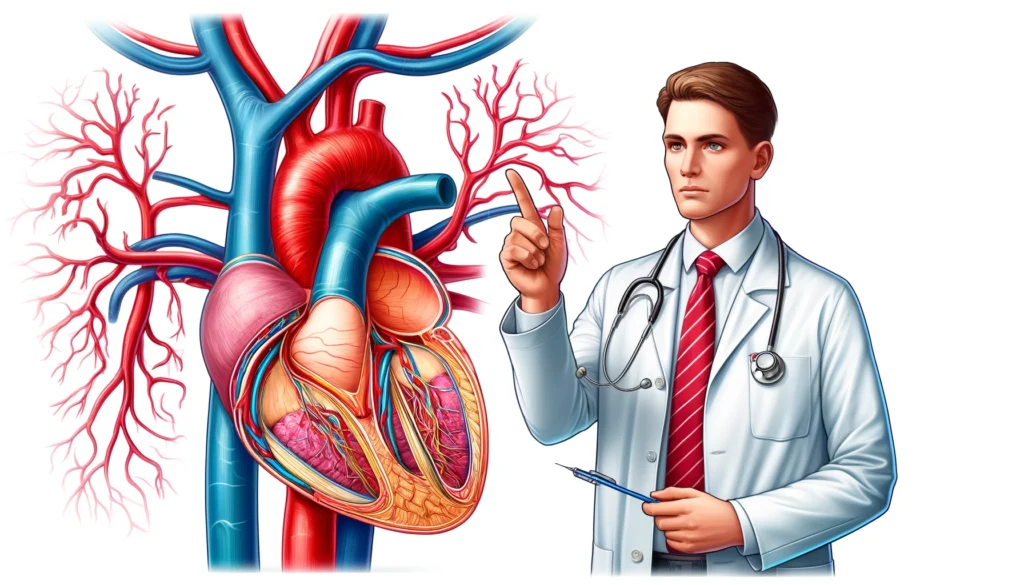The Cardiovascular System: The Lifeline of the Body

Understanding the Cardiovascular System
Understanding the Cardiovascular System
What is the Cardiovascular System?
The cardiovascular system, also known as the circulatory system, is responsible for transporting blood, nutrients, oxygen, and hormones throughout the body. It consists of the heart, blood vessels, and blood, working together to sustain life by ensuring that all body tissues receive the necessary substances to function correctly.
Major Components of the Cardiovascular System
The Heart
The heart is a muscular organ located in the chest cavity. It functions as the system’s pump, maintaining blood circulation through rhythmic contractions. The heart is divided into four chambers: two atria and two ventricles. The right side of the heart pumps deoxygenated blood to the lungs, while the left side pumps oxygenated blood to the rest of the body.
Blood Vessels
Blood vessels are a network of tubes that carry blood throughout the body. They include arteries, veins, and capillaries. Arteries transport blood away from the heart, veins return blood to the heart, and capillaries connect arteries and veins, facilitating the exchange of oxygen, carbon dioxide, and nutrients with body tissues.
Blood
Blood is a vital fluid that delivers oxygen and nutrients to cells and removes waste products. It consists of red blood cells, white blood cells, platelets, and plasma. Each component has a specific role: red blood cells carry oxygen, white blood cells fight infection, platelets help with clotting, and plasma carries nutrients, hormones, and proteins.

The Importance of Cardiovascular Health
Common Disorders
Cardiovascular diseases are the leading cause of death worldwide. Conditions such as hypertension (high blood pressure), coronary artery disease, heart attacks, and strokes can significantly impact health. These disorders often result from poor lifestyle choices, genetic factors, or other underlying conditions.
Maintaining Health
To maintain a healthy cardiovascular system, it’s crucial to adopt a balanced diet, engage in regular physical activity, avoid smoking, and manage stress. Regular check-ups with a healthcare provider can help detect and manage risk factors early, preventing serious health issues.
The cardiovascular system is essential for sustaining life by delivering vital substances to all body parts. Understanding its function and maintaining its health is crucial for overall well-being. By taking proactive steps to care for your cardiovascular system, you can enhance your quality of life and prevent diseases.
“An ounce of prevention is worth a pound of cure.”
Sign up for our free newsletter to receive a detailed PDF about the cardiovascular system, including tips for maintaining heart health and preventing cardiovascular diseases. Stay informed and take control of your health today!

El Sistema Cardiovascular: La Línea de Vida del Cuerpo
Entendiendo el Sistema Cardiovascular
¿Qué es el Sistema Cardiovascular?
Definición y Función
El sistema cardiovascular, también conocido como el sistema circulatorio, es responsable de transportar sangre, nutrientes, oxígeno y hormonas por todo el cuerpo. Consiste en el corazón, los vasos sanguíneos y la sangre, trabajando juntos para sostener la vida al asegurar que todos los tejidos del cuerpo reciban las sustancias necesarias para funcionar correctamente.
Componentes Principales del Sistema Cardiovascular
El Corazón
El corazón es un órgano muscular ubicado en la cavidad torácica. Funciona como la bomba del sistema, manteniendo la circulación sanguínea mediante contracciones rítmicas. El corazón está dividido en cuatro cámaras: dos aurículas y dos ventrículos. El lado derecho del corazón bombea sangre desoxigenada a los pulmones, mientras que el lado izquierdo bombea sangre oxigenada al resto del cuerpo.
Vasos Sanguíneos
Los vasos sanguíneos son una red de tubos que transportan sangre por todo el cuerpo. Incluyen arterias, venas y capilares. Las arterias transportan sangre fuera del corazón, las venas devuelven la sangre al corazón, y los capilares conectan arterias y venas, facilitando el intercambio de oxígeno, dióxido de carbono y nutrientes con los tejidos del cuerpo.
La Sangre
La sangre es un fluido vital que entrega oxígeno y nutrientes a las células y elimina productos de desecho. Consiste en glóbulos rojos, glóbulos blancos, plaquetas y plasma. Cada componente tiene un rol específico: los glóbulos rojos transportan oxígeno, los glóbulos blancos combaten infecciones, las plaquetas ayudan en la coagulación y el plasma transporta nutrientes, hormonas y proteínas.
La Importancia de la Salud Cardiovascular
Trastornos Comunes
Las enfermedades cardiovasculares son la principal causa de muerte en todo el mundo. Condiciones como hipertensión (presión arterial alta), enfermedad de las arterias coronarias, ataques cardíacos y accidentes cerebrovasculares pueden afectar significativamente la salud. Estos trastornos a menudo resultan de elecciones de estilo de vida poco saludables, factores genéticos u otras condiciones subyacentes.
Manteniendo la Salud

Para mantener un sistema cardiovascular saludable, es crucial adoptar una dieta equilibrada, realizar actividad física regular, evitar fumar y manejar el estrés. Las visitas regulares al proveedor de atención médica pueden ayudar a detectar y gestionar los factores de riesgo temprano, previniendo problemas de salud graves.
El sistema cardiovascular es esencial para sostener la vida al entregar sustancias vitales a todas las partes del cuerpo. Entender su función y mantener su salud es crucial para el bienestar general. Al tomar medidas proactivas para cuidar tu sistema cardiovascular, puedes mejorar tu calidad de vida y prevenir enfermedades.
“Más vale prevenir que lamentar.”
Suscríbete a nuestro boletín gratuito para recibir un PDF detallado sobre el sistema cardiovascular, incluyendo consejos para mantener la salud del corazón y prevenir enfermedades cardiovasculares. ¡Mantente informado y toma el control de tu salud hoy!